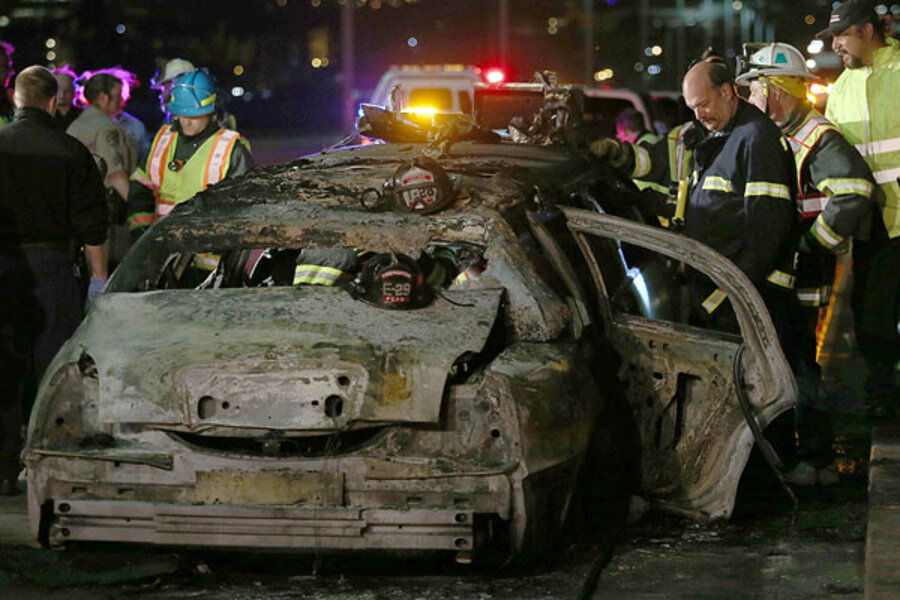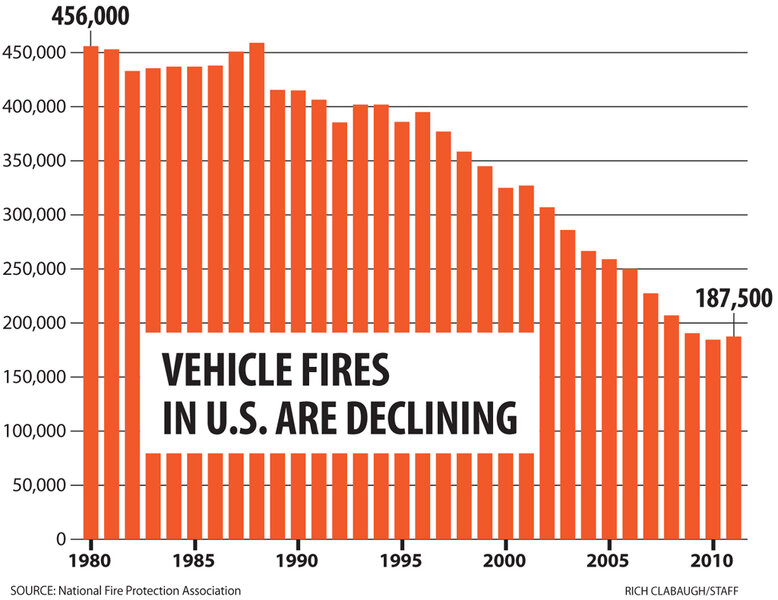Limo fire that killed bride puzzles experts
Loading...
The number of highway vehicle fires has been decreasing since the 1980s, but the limousine fire near San Francisco Saturday shows the need for passengers to know what to do during such an incident, fire experts say.
The limousine that broke out in flames, killing five women and injuring four more, was carrying one too many passengers, California Highway Patrol Capt. Mike Maskarich said during a press conference Monday. The vehicle was crossing the San Mateo-Hayward Bridge when the rear end of the vehicle caught fire. The passengers could not exit the car doors because of the flames, and the driver was able to help four survivors escape through the partition window. Investigators have not determined a cause.
“It’s an anomaly within our business that people would die in a vehicle without a crash and being trapped with no exit choice,” says Ron Moore, a vehicle rescue expert. In his 32-year career as a firefighter and fire rescue trainer, he has not seen a limousine fire like this.
“Normally, fires start in the engine, so you have a more controlled situation,” he says. Only 4 percent of vehicle fires originate in the trunk or cargo area, according to a report by the US Fire Administration released in January, compared with 61 percent of fires that start in the engine area, running gear, or wheel area.
During his fire safety training, Mr. Moore tells everyone that during a vehicle fire, “there is only time to do the right thing once.” Passengers should have a plan of what to do before they get in the vehicle.
His safety suggestions are similar to recommendations provided by the National Fire Prevention Association (NFPA) and the US Fire Administration:
- As soon as you sense something is wrong, or smell burning plastic, pull the car over and turn off the ignition.
- Get out and move away from the vehicle – uphill and upwind, if possible – and maintain a distance of more than 100 feet.
- Do not try to extinguish the fire yourself, but call 911 and wait for the fire department.
Passengers should not try to put out fires on their own, even if they have a fire extinguisher. Most people don’t have a large enough extinguisher, or the right chemicals.
“It’s a great risk if a citizen is trying to put one out,” says Moore. “Most fire departments will say to stay clear until they arrive – they have the right training and equipment.
Another precautionary method is making sure that vehicles are well maintained and that they meet federal and local safety requirements, the NFPA suggested. The California Public Utilities Commission, which regulates limousines in California, recommends that people check that the limousine carrier is licensed by local or state regulating agencies and that the company has liability insurance before renting. Passengers can ask to inspect the car they are renting.
There are danger signs that people can look for, including cracked or loose electrical wiring, oil or fluid leaks, and underinflated tires. These are among the main causes of vehicle fires, according to the US Fire Administration report.
Mechanical and electrical issues are the most common causes of vehicle fires, which accounted for 16 percent of all fires in the US during 2011, according to the NFPA. On average, 25 highway vehicle fires were reported per hour that year, and there were 219,000 vehicle fires, causing 300 deaths and 1,190 injuries. In 1988, there were 459,000 vehicle fires, which caused 800 deaths and 2,750 injuries.
Three of every 5 vehicle fire deaths occur during collisions or overturns, the NFPA reports, which is another reason the limousine fire was unusual.
“It is unusual for limousines to be involved in this these types of accidents,” said Philip Jagiela, executive director of the National Limousine Association, in a statement. “There are 110,000 chauffeured vehicles in service in the United States according to the limousine industry trade magazine, Limousine, Charter and Tours. They make thousands upon thousands of trips per year. Incidents like this are truly an anomaly.”









